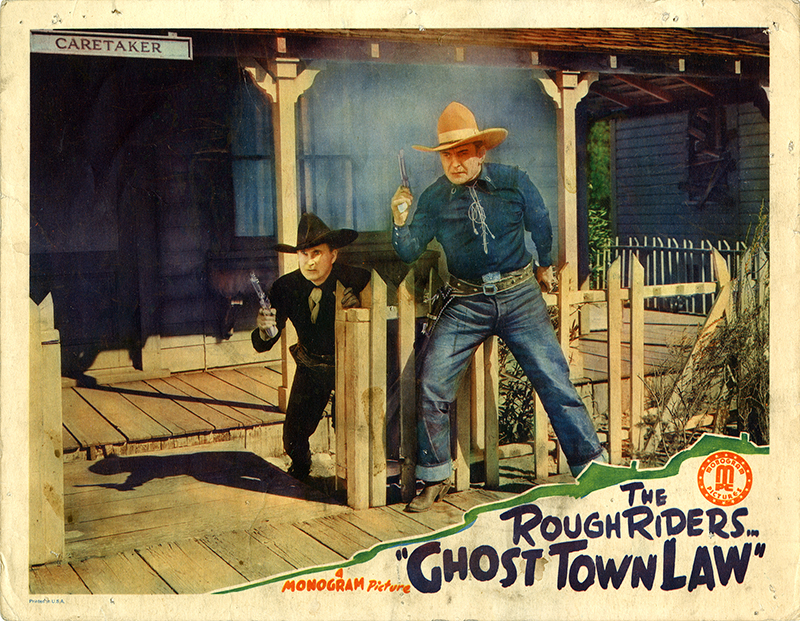"Ghost Town Law"
Melody Ranch | Placerita Canyon

Click image to enlarge
| Download archival scan
Tim McCoy, left, and Buck Jones keep a sharp lookout at Ernie Hickson's Monogram/Placeritos Ranch (later called Melody Ranch) in 1942's "Ghost Town Law," the fifth of nine "Rough Riders" pictures starring McCoy, Jones and Timothy Hatton — or fifth of eight if you don't count the last one, which McCoy skipped. Rather than renew his contract with Monogram, McCoy enlisted in the Army, made full colonel and earned a Bronze Star for meritorious service with the Army Air Corps in Europe. Ironically, it was Jones who died during World War II — but not as a member of the military. He was one of 492 casualties of the infamous Cocoanut Grove nightclub fire in Boston. McCoy made a brief return to motion pictures in the mid-1950s and died in 1978 in the Army hospital at Fort Huachuca, Arizona. He was 86.
The Life and Untimely Death of Buck Jones. Buck Jones was an A-lister among the "B" Western actors of the 1920s-30s-40s. A popular hero of dime novels and comic books, promoter of Grape-Nuts cereal and Daisy air rifles, Jones frequently starred in films shot at Placerita Canyon and Vasquez Rocks, and he came out of retirement during the war, when younger stars were off serving, to co-star in eight "Rough Riders" buddy pictures for Scott R. Dunlap at Monogram (after Dunlap had made a mid-career move in the 1930s to serve as Jones' business manager). The end of Jones' career didn't come by choice. He died as a result of traumatic burn injuries sustained in the famous Cocoanut Grove fire of Nov. 28, 1942, the deadliest nightclub fire in U.S. history. Flames started downstairs and quickly spread through the Boston nightclub; a single revolving door was the only way out. Jones was counted among the 492 casualties when he died at a hospital two days later. Jones was at the Grove because Dunlap was throwing a party in his honor. Dunlap was seriously injured but survived. Monogram exec Trem Carr was credited (or blamed) for spreading the rumor that Jones sustained his fatal injuries when he rushed back into the burning building to rescue victims, but in fact Jones was trapped behind a wrought-iron railing that incapacitated him in his seat directly across from the bandstand. Born Charles Frederick Gebhart on Dec. 12, 1891, in Vincennes, Ind. — some sources erroneously say Dec. 4, 1889 — he joined the U.S. Army in 1907 at age 16 and earned the Purple Heart during a rebellion in the Philippines. Discharged in 1909, he pursued and interest in auto racing and went to work for Marmon Motor Car Co. He reenlisted in the Army in 1910 and served until 1913, after which he busted broncs on the Miller Bros. 101 Ranch in Oklahoma where he met his bride, Odille "Dell" Osborne. The outbreak of World War I saw him training horses for the allies. Later, a Wild West Show took him to Los Angeles where he got work at Universal as a $5-a-day stuntman and actor. He went to Canyon Pictures and then to Fox Film Corp., earning $40 a week for stunt work. Fox eventually used him as a backup to Tom Mix, raised his salary to $150 a week, and gave him his first starring role in 1920's "The Last Straw." By the mid-1920s he was at least as big a star as Mix, Hoot Gibson or Ken Maynard. In 1928 he formed his own production company, but it was ill-timed. The silent period was closing and Westerns fell into a brief decline; and when the stock market crashed the following year he lost his shirt. He then tried to form his own Wild West show but it, too, failed, and after a year away from the screen, Jones landed at the Poverty Row studio Columbia Pictures at $300 a week, a fraction of his top silent-era salary. (Columbia hadn't yet broken out with 1934's "It Happened One Night.") Westerns roared back in the 1930s and Jones did, too. His masculine voice caught on with audiences as he starred in pictures for Columbia and Universal which were often shot in the Santa Clarita Valley. At one point he received more fan mail than any other actor. The early 1940s saw him co-produce a string of movies with his friend Dunlap, who teamed him up with Tim McCoy and Raymond Hatton to form the Rough Riders. Further reading: Buck Jones, Bona Fide Hero by Joseph G. Rosa, 1966.
LW3644: 9600 dpi jpeg from original 11x14 lobby card purchased 2019 by Leon Worden.
|



